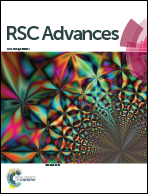Bilayered photoanode consisting of zinc oxide hollow spheres and urchin-like titanium dioxide microspheres enables fast electron transport and efficient light-harvesting for improved-performance dye-sensitized solar cells†
Abstract
Derived from ZnO hollow spheres (ZHSs) as the underlayer and urchin-like TiO2 spheres (UTSs) as the light scattering overlayer, a new bilayered photoanode (ZHS + UTS) is fabricated for use in dye-sensitized solar cells (DSSCs). The ZHSs which directly grow on FTO are synthesized via a one-pot hydrothermal method. The DSSC based on the ZHSs achieves an overall photoelectric conversion efficiency (PCE) of up to 4.84%, which is mainly ascribed to fast electron transport. On the other hand, three kinds of UTSs of different size and morphology are prepared by simply adjusting the titanium precursor dosage. The hierarchical UTSs composed of needle-like thin nanosheets have large specific surface areas, enabling sufficient dye adsorption. In particular, UTS-2 (synthesized using a TiCl3 volume of 0.6 mL) shows strong light-scattering ability and hence is further applied as a scattering layer in the bilayered photoanode. The ZHS + UTS-2 based DSSC finally achieves the highest photocurrent density (Jsc = 18.13 mA cm−2) and therefore an enhanced PCE of 8.67%. The improved photovoltaic performance is attributed to the synergic effects of the ZHSs and UTSs, i.e. the fast electron transport favored by the highly crystallized ZHSs leading to a reduced interfacial charge recombination, the efficient light scattering effect due to the novel morphology of the UTSs, and the sufficient dye adsorption ensured by the large specific surface areas of the ZHSs and UTSs.


 Please wait while we load your content...
Please wait while we load your content...